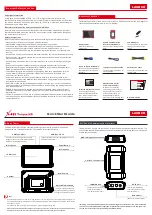
4
EN
There can be no inversion or fluctuations of pressure between the intermediate chamber and the circuit upstream of the backflow
preventer. The construction of the device in accordance with standards requires the upstream pressure to remain 140 mbar higher
than the pressure in the intermediate chamber at all times. This differential value controls the opening of the relief valve and the
drainage of the backflow preventer. Backflow preventers with verifiable reduced pressure zones self-protect against their own
malfunctions. The device is made safe in static pressure situations.
The following situations can arise:
1.1 Operating principles
1.2 Malfunctions
UPSTREAM
NEGATIVE
PRESSURE /
BACK-SIPHONAGE
The two check
valves close.
The relief valve
opens and drains
the intermediate
chamber.
OVERPRESSURE
WITH
DOWNSTREAM
VALVE SEALED
If the check valve is
perfectly sealed, no
malfunction will occur:
the valve remains
closed.
NORMAL FLOW CONDITIONS > FILLING / FLOW
START
The two check valves are opened. The relief valve is
closed (closing pressure is lower than the upstream
check valve opening pressure). Water is supplied to the
downstream chamber.
NO FLOW CONDITIONS > FLOW INTERRUPTION
The two check valves are closed. The relief valve is closed
(because the pressure required to close it is lower than
the pressure required to open the upstream check valve).
NO FLOW WITH
UPSTREAM VALVE
DEFECTIVE
The upstream
pressure increases
the pressure in the
intermediate chamber.
The relief valve
opens and causes a
continuous discharge.
OVERPRESSURE
WITH
DOWNSTREAM
CHECK VALVE
DEFECTIVE
The overpressure
reaches the
intermediate chamber
causing the relief valve
to open and discharge
into the sewage
network.





































